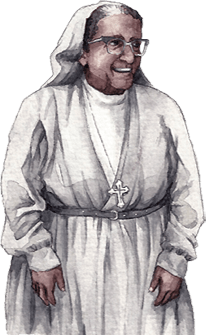Prayer Group Of Our Lady Of The Mystique Rose > Prayers > Complementary Texts
Complementary Texts
History Of Prayers
Hail Mary Prayer
Prayer inspired by the Annunciation of the Angel Gabriel to Our Mary (Luke1, 28b), and the greeting of Saint Elisabeth, when she receives a visit of the Virgin Mary in her house (Luke 1: 42b).
In the year of 431 AC., the dogma of motherhood of the Mother of God was defined at the end of the Council of Ephesus, by the Pope St. Celestine, who, kneeling, hailed the Our Lady in these terms: "Holy Mary Mother of God, pray for us sinners, now and at the hour of our death. Amen”. This greeting has become the 2nd part of the Hail Mary.
Our Father Prayer
Prayer taught by Jesus (Luke 11.1 to 4 / Mathew 6, 9-13), in response to the request of one of his disciples, also trusting His Church the prayer that became the fundamental Christian prayer. In the Lord's Prayer, the first three requests are aimed at the glory of the Father: the sanctification of His Holy Name, the coming of the Kingdom and the fulfilment of the Divine Will. The four following requests concern to our life, either to nourish it or to heal it of sin and are related to our struggle, seeking the glory of the Good over evil.
Litany of the Blessed Virgin Mary
The word litany comes from Greek and means supplication. However, since the beginning of the Church, it was actually not used to designate any pleas, but those who were prayed together by the faithful who used to go in procession to the various churches. There are many litanies of Our Lady, but the most widespread and well-known is the "Litany of Loreto", or "Loretana", so called due to becoming popular in the Shrine of Loreto in Italy, where it was solemnly sung for the first time, on December 10th ,1531, spreading itself gradually throughout the world.
After the introduction of the litany, there are three invocations, in which we utter the name of the Virgin (Holy Mary) and recall her main attributes: being the Mother of God and Virgin of virgins. Subsequently there are 13 invocations in honor of the Maternity of Our Lady, and another six in honor of her virginity, besides 13 attributes, four invocations to her mercy and, eventually, 12 invocations to her as glorious and powerful Queen.
Office of the Immaculate Conception
Written in Italy in the fifteenth century by the Franciscan Bernardino de Bustis and approved by Pope Innocent XI in 1678, the Office of Our Lady is an act of praise and thanksgiving to the Virgin Mary, Mother of God, through her Immaculate Conception (dogma of the Church proclaimed on 12/08/1854 by Pope Pius IX). It can be sung or recited at one time or according to the Liturgy of the Hours, in order to protect the sanctity of the Immaculate Conception. There are reports saying that that when one prays the Office of the Immaculate Conception, She kneels in heaven interceding for those who pray it. In the reform of the Council Vatican II, the Pope Paul VI granted plenary indulgence to those who pray the Office of the Immaculate Conception in faith.
Creed Prayer
The prayer of the Creed was constituted by the apostles and the early successors, so that the Christian people would keep in memory the main points of the Catholic faith revealed by Jesus Christ. This prayer is divided into three parts. Firstly it refers to the First Divine Person and the admirable work of creation. Then it mentions the Second Divine Person and the Mystery of the Redemption of mankind, and eventually to the Third Divine Person, origin and source of our sanctification. Reciting the Creed with faith is getting into communion with God: Father, Son, and Holy Spirit. It is also getting into communion with the whole Church, which transmits the faith in which we believe.
Hail Holy Queen Prayer
The origin of this prayer is attributed to the Monk Germano Contratus, who, started its composition around the year 1049; he couldn’t finishing it due to the event of his death, as he was writing: "after such exile show us unto Jesus". The conclusion of this prayer was carried out by St. Bernard in the mid-twelfth century, in the imperial city of Speyer. While he was out preaching on the 2nd Crusade, in a burst of love with his eyes fixed on the image of the Holy Virgin, he made three genuflections exclaiming: “O Merciful, O loving, O sweet Virgin Mary!”, thus completing the prayer of the Monk Germano. These words were carved in brass blades on the floor of the Cathedral and then, introduced in the prayer Hail Holy Queen.


